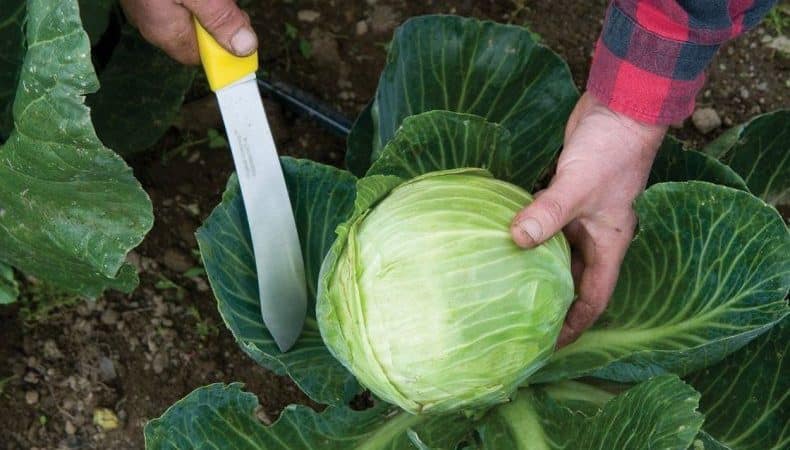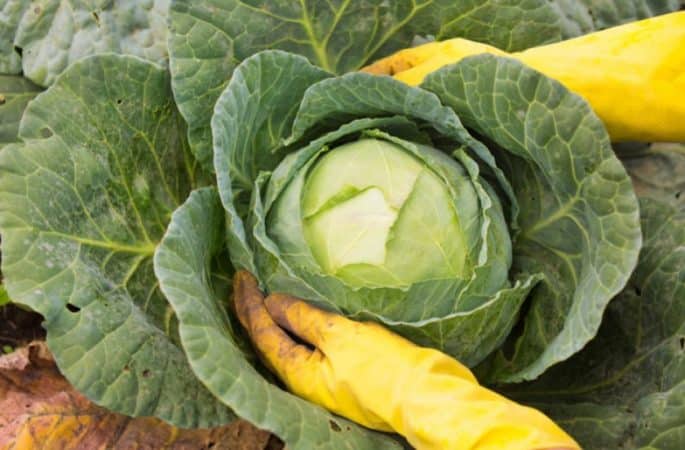Do I need to pick off the bottom leaves of cabbage?
While cabbage is ripening, some vegetable growers pick off its lower leaves. Many people do not share this approach, because this part of the plant is also used for food and harvested with the rest of the harvest. Removing leaves helps improve the quality of the head in some cases, which we will discuss in detail below.
Do I need to pick off the bottom leaves of cabbage?
A head of cabbage ripens correctly due to the beneficial substances that are located in the lower part. After its removal, the crop begins to grow leaves again, so the vegetable stops growing for some time. A small coating at the bottom protects against pathogens entering the plant.

The lower leaves of cabbage are removed in the following cases:
- prevention and treatment of diseases;
- prevention of pest proliferation;
- increasing the ripening period in early varieties;
- prevention of rotting and cracking;
- with a loose cabbage structure;
- when plants are densely planted;
- to increase the weight of heads of cabbage.
With vascular bacteriosis, plants begin to die from below. Some gardeners mistakenly think that after removing the leaves the disease will disappear, but this is not enough. When removing the lower part for preventive purposes, the vegetable grower makes the cabbage more vulnerable.
In the case of pests, the situation is different. For example, the cabbage fly attaches eggs to the lower leaves, which are best to tear off and burn. To completely destroy pests, insecticides are additionally used (for example, Actofit).
Attention! It is not recommended to get rid of the bottom part of the vegetable in advance. In this case, the insects will lay eggs in another part of the head of cabbage.
Inexperienced gardeners try to slow down the growth of early varieties by tearing off leaves. This method is not suitable for these purposes: cabbage not only stops developing, but becomes more susceptible to diseases. To increase the ripening period, it is better to tear the root system by lifting and turning the head of cabbage around its axis by 50–70°.
But cutting off the foliage to prevent rotting really works. When the soil becomes waterlogged, vegetables often begin to rot. To prevent the process from spreading, the damaged part is cut off.
The procedure is also carried out to ensure that the head of cabbage does not overripe and crack. It is performed when the cabbage reaches optimal maturity. It will slow down development only for a while.
If the structure of the head of cabbage is loose, this procedure is also performed. Beneficial substances continue to accumulate in the lower leaves. In this case, they are redirected higher up the plant. However, the best way to deal with looseness is to apply fertilizer.
Some summer residents mistakenly believe that tearing off the lower parts of the cabbage will increase its size and weight. On the contrary, this procedure significantly slows down the development of the plant, and if you harvest from the garden along with the foliage, the heads of cabbage will continue to grow during storage. In some cases, the weight gain is up to 15%.
If planting is too dense, only the largest leaves that interfere with neighboring plants are removed.
The procedure is not carried out in the following cases:
- Before the ovary appears. In order for a head of cabbage to form in the rosette, there must be at least 7 leaves. If you cut off several of them from the very beginning, the ovary will form much later.
- After harvest, provided that the lower tier is not damaged by diseases or pests.
When to remove the lower leaves of cabbage
The lower part is cut off no earlier than the end of August. By this time, it is no longer so important for the development and normal growth of the head of cabbage.
Important! If signs of disease or pest damage are detected, the procedure is carried out earlier. Collected waste must be removed from the garden bed and burned.
All actions are carried out only on a sunny and dry day, so that the damaged areas dry out quickly.
Pruning in autumn

It is important to do pruning so that the plant endures minimal stress, otherwise there is a high risk of harming the crop and not getting a high-quality harvest.
How to remove lower leaves:
- Choose a dry day.
- It is advisable not to tear off the lower part, but carefully cut it off with a sharp and disinfected knife.
- Immediately sprinkle each cut with wood ash. This will prevent bacteria and viruses from penetrating into plant tissues.
- It is permissible to remove no more than 1 sheet in 1 week. The old cut must be completely healed before the next one is removed.
The health and number of leaves on the stem affect the volume and quality of the harvest, so they are cut only when absolutely necessary. If pruning rules are followed, the plant will suffer minimal damage, but damage will still occur.
If circumcised the leaves are healthy, they are usually used as feed for livestock. Cabbage contains many vitamins, which are especially important in the fall. The bottom part of the vegetables is suitable for rabbits, goats, cows and birds.
Care after removing the lower leaves

After pruning, it is not recommended to water the cabbage beds for the first 2-3 days. Due to moisture, active sap flow begins, which negatively affects the speed of drying of the cuts.
To improve the taste of cabbage and increase its shelf life, phosphorus-potassium fertilizers are applied in September. For 10 liters of water dilute 2 tbsp. l. facilities. As a result, the leaves will become denser, which will save the heads of cabbage from rotting.
Still active in warm autumn aphid. It is important to constantly monitor its appearance. To get rid of this pest, use a soap solution: dilute 40 g of soap per 1 liter of water. After processing, everything is sprinkled with ash.
In autumn they cause the most damage slugs. Slaked lime is used against them: 50 g of powder is scattered per 1 m².
This is interesting:
Why cabbage leaves turn yellow and what to do about it
Conclusion
Vegetable growers have mixed opinions about removing the lower leaves of cabbage heads. Some argue that this protects the plants, others argue that it harms the crop. Only one thing is clear: removing the lower leaves is useful when cabbage is infected with diseases or attacked by pests.